
- Home
- Travel Packages
- Top Destination
-
Travel Attraction
By Category
Top Attraction

- Travel Agents
- Car Rentals
- Hotels
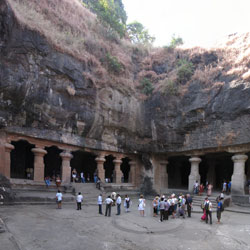
An interesting travel of about an hour by boat from the Gateway of India, passing the Mumbai harbour, and the Naval barges, takes you to Elephanta Caves where there are caves with carvings dedicated to Lord Siva. It is an UNESCO World Heritage site. The Elephanta Island is the site of the magnificent Elephanta caves, containing beautiful carvings, sculptures, and a temple to the Hindu God, Lord Shiva. The island of Elephanta, being a commercial, military and religions centre for centuries has traces of early Buddhist culture.One of the major Tourist Attractions of Maharashtra, the Elephanta Caves are situated near the metropolitan city of Mumbai. The Elephanta island is located 10 Kms away from the Gateway of India. There are various rock cut temples present in these caves, which are as old as 5th century. The Elephanta Island was named by the Portuguese, after the statue of an elephant near the landing area of the island. Construction of The Caves : The rock cut temples in Elephanta Caves are carved out of rock. There are columns, internal spaces and images within these temples. The entire temple is related to a large sculpture. In fact one can walk through the corridors and chambers of this sculptured temple. Created through a process of rock removal, the entire complex is an interesting monument. Some of the rock surfaces here are finely finished whereas some are unfinished bare rock. The Elephanta rock caves are sprawled over a large area of about 60000 square feet. These temple caves consist of a main chamber, courtyards and several subsidiary shrines. There is also a mass of natural rock, above the temple. There are three entrances to the temple. The eastern and the western entrances mark the axis of the temple. There is a 20 pillared hall that lines the axis, and on its western end is a cell in which a Shivalingam enshrined. The Mystical Images : The magnificent image of Sadasiva, a manifestation of Shiva, is carved in relief at the end of the north south axis. The stupendous 20 feet high image of the three headed Shiva, known as Trimurthy is a magnificent one. It is regarded as a masterpiece of Indian art. This huge image represents Panchamukha Shiva, whose only three faces are carved into the wall. It attracts your attention just as you enter the temple through the northern entrance. Along with this image there are grand sculptured images of Kalyanasundara, Gangadhara, Ardhanariswara and Uma Maheswara on the southern wall. Other sculptured images of Nataraja and andhakaasuravadamoorthy are to the west of the northern entrance and the images of Yogiswara and Ravanaanugrahamurthy are to its east.
Explore More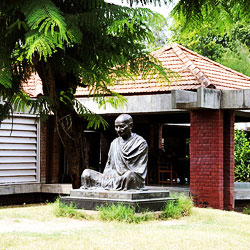
The Gandhi Ashram situated alongside the Sabarmati River, was the nerve center for the Indian Freedom movement. The beautiful ashram complex with it's shady trees offers a refuge from the loud streets of the city. There is a museum inside the Ashram complex. During the lifetime of Mahatma Gandhi it was known as Satyagraha Ashram.
Explore More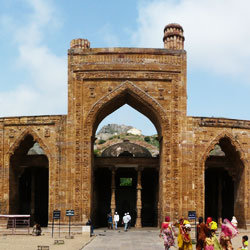
Adhai Din Ka Jhonpra is a remarkable structure of Indo-Islamic architecture said to have been built in two and a half days flat. This mosque was a Sanskrit college in the 12th century but in 1193 AD Mohammad Ghori destroyed the college and built a mosque in its place. It is built on pillars and surprisingly no two pillars are alike. The distinct pillars-and arched 'Screen' with its ruined minarets make it a splendid architectural masterpiece. The monument has seven arched walls with Islamic calligraphy, though most of it now remains in ruins. 'Adhai Din Ka Jhonpra' literally means 'shed of two-and-a-half days'. As mentioned earlier, a legend states that a part of the mosque was built in two-and-a-half days. Some Sufis claim that the name signifies a human's temporary life on the earth. According to the ASI, the name probably comes from a two-and-a-half-day-long fair that used to be held at the site. Har Bilas Sarda points out that the name 'Adhai-Din-ka-Jhonpra' is not mentioned in any historical source. Before the 18th century, the mosque was simply known as a 'Masjid' ("mosque"), since it had been the only mosque in Ajmer for centuries.
Explore More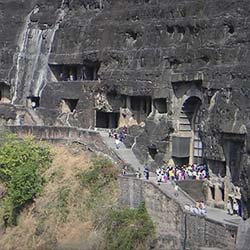
About Ajanta Caves History The Ajanta Caves, located in Aurangabad, India, are a set of 30 rock-cut Buddhist cave monuments dating back to the 2nd century BCE. These caves were abandoned in the 7th century and rediscovered in 1819 by a British officer named John Smith. The caves showcase ancient Indian art and architecture, depicting tales from the Jataka stories and the life of Buddha. Architecture and Design The Ajanta Caves are renowned for their intricate carvings, sculptures, and frescoes. The caves are carved out of solid rock and feature chaityas (prayer halls) and viharas (monasteries). The architecture reflects a blend of Buddhist and Hindu styles, with elaborate pillars, intricate ceilings, and detailed sculptures. Best Time to Visit The best time to visit the Ajanta Caves is during the cool and dry months of October to March. The weather during this time is pleasant, making it ideal for exploring the caves and enjoying the surrounding landscapes. Cultural Significance The Ajanta Caves hold immense cultural significance as they provide a glimpse into ancient Indian art, architecture, and religious beliefs. These caves are a UNESCO World Heritage Site and are considered a masterpiece of Buddhist religious art, showcasing the evolution of Indian art over centuries. Pilgrimage Practices Many visitors to the Ajanta Caves come on a pilgrimage to pay homage to Buddha and explore the spiritual significance of the caves. Pilgrims often engage in meditation, chanting, and offering prayers at the various shrines and stupas found within the caves. Dress Code and Etiquette Visitors are required to dress modestly when visiting the Ajanta Caves, as they are considered a sacred site. It is advisable to wear comfortable clothing that covers the shoulders and knees. Respectful behavior and quiet demeanor are expected inside the caves to maintain the sanctity of the place. Activities and Experiences Visitors to the Ajanta Caves can engage in a variety of activities and experiences, including guided tours, photography, and exploring the intricate details of the cave art. Many visitors also enjoy witnessing the mesmerizing light and sound shows that bring the history of the caves to life. Art and Religious Symbols The Ajanta Caves are adorned with stunning artworks, frescoes, and sculptures depicting various religious symbols and stories from Buddhist mythology. The art within the caves showcases intricate carvings of Buddha, Bodhisattvas, and scenes from the life of Buddha, illustrating the spiritual and artistic prowess of ancient India. Local Insights Local guides and historians often provide valuable insights into the history, significance, and artistry of the Ajanta Caves. Visitors can learn about the various cave structures, the symbolism behind the artwork, and the cultural context of the caves, enhancing their overall experience and understanding of this ancient site.
Explore More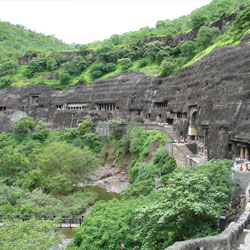
Just outside the city, are located the 6th century caves displaying the influence of Tantric cult in the iconography and architectural designs of the caves. A major chunk of the caves are viharas, of which Caves 3 and 7 are most fascinating. These were excavated between the 2nd and 6th century AD. Tantric influences can be discerned in their architecture and iconography. There are twelve caves in all, a major chunk of which are viharas, of which Caves 3 and 7, are the most fascinating. Cave 3 stands supported by 12 finely carved columns, and sports sculptures portraying scenes from the Jataka tales. Cave 7 houses an imposing sculpture of a Boddhisattva, praying for deliverance. Some of the chaitya halls here are constructed on a mandala plan for the circumambulation of the Buddha who is depicted here seated on an intricately carved throne. A short walk from Bibi-Ka-Maqbara is a set of caves slighted by their more glamorous neighbours, Ajanta and Ellora. The western group consists mainly of viharas (monasteries) and depictions from the Jataka tales. At the eastern group, there are sculptures of scantily clad buxom women in freaky hairdos, child-eating goddesses, musicians and dancers alongside images of the Buddha. This is indicative of the rise of Tantric Buddhism during the 6th and 7th century A.D. Nestled amidst the hills are 12 Buddhist caves probably dating back to the 1 A.D. One is also treated to a panoramic view of the city as well as the imposing Maqbara from this point. These caves are carved out of the hillside and are a fine piece of architecture, housing the most stunningly intricate carvings.
Explore More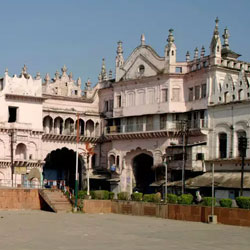
Shaukat Mahal And Sadar Manzil
The Shaukat Mahal and Sadar Manzil show a blend of Asian and Western styles of architecture which creates this building stand out in the crowd of the traditional Islamic architecture of Bhopal. Shaukat Mahal Travel Tips Recommended time of arrival: 8.00 am – 6.00 pm Shaukat Mahal Timings The place is open during the office hours of the Municipal Corporation. It is advised to check the history and customer’s reviews on the website of a travel operator. Timings for Entry It is advised to take a trip of the two during the morning hours or in the evening to enjoy the atmosphere of the place. Shaukat Mahal and Sadar Manzil can be visited through the timings of 7:00 AM - 7:00 PM in April to September, and from 7:00 AM to 6:00 PM from October to March. The buildings rest closed for visitors on Fridays. There are no pass or entry fees for both Shaukat Mahal and Sadar Manzil. Festival of Bhopal Looking Festival: It is held in January for around 4 days annually, the festival promotes folk dances to merge geopolitical boundaries and limits. History of Shaukat Mahal and Sadar Manzil The history of Shaukat Mahal and Sadar Manzil tells that it was designed by a corrupt Frenchman who is known to be from the Bourbon Dynasty of France. The Shaukat Mahal and Sadar Manzil imitate an exclusive blend of oriental and occidental architectural styles. Description of Shaukat Mahal and Sadar Manzil Gothic and post resurgence styles have been efficiently used in the construction of the Shaukat Mahal, which ultimately gives it an enchanting effect. Many convolutedly carved arches on the roof of the Shaukat Mahal beside with the alabaster white structure of the building give it a distinctive look. The outside of the palace is decorated with beautiful and exotic floral designs giving the Shaukat Mahal an eco-friendly appearance. The Sadar Manzil that was the Hall of Public Audience through the rule of the princes borders the Shaukat mahal. This building is a brick red structure of flamboyant appearance. The Shaukat Mahal and Sadar Manzil are bounded by beautiful lawns that give it a picture postcard effect. How to reach Shaukat Mahal and Sadar Manzil? The Shaukat Mahal and Sadar Manzil are situated at the entry of the Chowk area, in the centre of the city. It is simply reached by all modes of transport inside the city. The Mahal is amazingly attached by road. You can reach this place easily by bus at Moti Masjid Bus Stop and by Minibus, Rickshaw, Taxi, hiring a Cab. Best time to visit The best time to visit Bhopal is during the winter months of October to March. The weather is an ideal one for exploring and experiencing the rich flavours of the grand city. July-September is the second-best time to visit the city. Tourists spots nearby Shaukat Mahal • MP tourism boat club- It is an astonishing place for nature lovers, journey seekers, and experience seekers. When it comes to boating in the lake, this place is present an unforgettable boating experience. • Tattenham club- It is one of its kind pub in Bhopal. Based on the theme of horse racing it is a perfect place to relax with friends. • Newmarket- Experience some traditional shopping here. • Azad market- a recommended for having sumptuous food in Bhopal. Experience some native taste of Bhopal here. • Bhopal on the wheel- is a government initiative that offers a guided tour of the whole city in just a few hours. The tourists are engaged with the toy-train look-alike open bus. The initial point of the tour is Palash Residency. From there the bus goes via hills and the old city. • Regional museum of natural history- It is a small and beautiful museum of Natural History. It takes you to close to nature via many beautiful and informative models. It is bounded by the lush green garden. • Van Vihar National Park- this is a sprawling wildlife sanctuary in Bhopal. Snugged between Shamla Hills and Upper Lake, it is one of the most visiting places in Bhopal for nature lovers and bird watchers. The place is a home of many creatures like the leopard, sambar, nilgai, turtle, star tortoise, crocodile, langur, porcupine, wild boar, and chital.
Explore More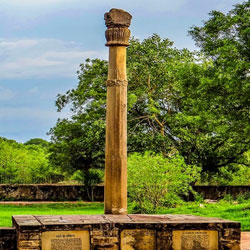
The Heliodorous Pillar, Vidisha was erected in central India, on the outskirts of Vidisha in 113B.C. The pillar is considered being one of the very important and significant archaeological finds on the subcontinent of India. The name of the pillar was given after Heliodorous, the ambassador of an Indo-Greek king from Taxila, named Antialcidas. On the pillar, he inscribed his dedication in Brahmi script, which declared him a Vasudeva devotee, or a devotee of the supreme deity. The pillar is said to be symbolic of the 'cosmic axis' and express the deity's cosmic totality it joins the earth's space and heaven. The Heliodorous pillar, Vidisha is located near two rivers. It is about 37 kilometers northeast from Bhopal, then 11 kilometers from Buddhist Sanchi stupa and then 4 kilometers from Udayagiri site. Alexander Cunningham discovered the Pillar in 1877. There were two major archaeological excavations done in the 20th century which revealed that the pillar was a part of the very ancient temple of Vasudeva. There are inscriptions and temples found which are known to be the earliest evidence of Vasudeva and Krishna's devotion. Also, it tells a lot about the early Vaishnavism existing in India. The inscriptions found on the Heliodorous pillar say that Vasudeva Krishna was called Deva which means the supreme deity, “God of Gods”. The Heliodorous pillar, Vidisha is the erection that shows the manifestation of Bhagavata, the worship of Vrishni heroes a type of ancient cult, and simultaneously there was also Buddhism flourishing in Sanchi. History: There was an excavation in the year 1913 which said that there was a significant part of the Heliodorous pillar, Vidisha which lies below the platform. It sits on top of even much more old and ancient pillar which probably got damaged by floods. Over time, there was silt from different floods that got deposited and the platform got raised at a point. The pillar shaft has base support made of the two placement stones which are held with the layer of a stone metal. Above it was the untrimmed stone part of the pillar. And above the section which is untrimmed lies an octagonal trimmed cross-section. The real ground level was around 4.5 centimeters above the trimmed and untrimmed section. Then above the length with the octagonal facet lies that section of the pillar which has sixteen facets. The section of thirty-two facets lies above the sixteenth section. Beyond this part is the round short pillar section, which goes all the way up to where previously was the crowning emblem, which is now missing. The pillar is around 17.7 feet above the square platform. The platform itself is above the ground for around 3 feet. The presently visible part of the octagonal portion of the pillar is around 4feet and 10inches high. The sixteenth section is completely visible and also is 6 feet and 2inches high. Also, the thirty twos are completely visible and it's around 11.5 inches high. While the round portion is around 2-feet 2-inches high. Inscriptions On the Heliodorous pillar, Vidisha is two inscriptions. The authors who have analyzed the inscriptions are Sukthankar, E.J.Rapson, Shane Wallace and Richard Salomon. The texts used in the inscriptions are written in Brahmi script the language which is used is Praktrit along with some Sanskritised spellings. The two inscriptions found on the pillar's octagonal base each spanning three sides along with the remaining two of the sides blank. • The very first inscriptions tell about the religious decoration of Heliodorous. The identity and name of the King Bhagabhadra are contested in the longer inscription. Some early scholars proposed that he might have been the very 5th ruler of the Dynasty of Sunga, as it has been described in some of the Puranic lists. • The second inscription did not have anything else but they’ve written about the lines from Mahabharata. • But, later in some excavation, done by German archaeologists near Sonkh, Mathura had shown, the end of the Sunga Dynasty happened even before the installation of Heliodorous pillar, Vidisha. Therefore, it can probably be true, that Bhagabhadra might have been some local ruler. Various other scholars have very differently translated the virtues in shorter inscriptions. Culture of Vidisha-Heliodorous pillar In the Heliodorous pillar, vidisha cultures there are mridang and matki music. Native festivals and functions are also enjoyed along with dance and music. While usually, different people are wearing different clothes depending on their changing cultures and religions. But the majority of all men almost wore the very traditional dhoti and mirza along with a turban. And for the women, there are legends and then choli and also there is chunni which does the work of covering up the head. There are also, very beautiful traditional handicrafts which include some kinds of cane works mad bamboo, ornament and metal crafts and folk paintings. Also, apart from just agriculture, there is tattooing done by people as another source of livelihood. Things to do: There many points of interests to visit when you are around Vidisha, in Madhya Pradesh. • The District Museum- In Vidisha, there is an amazing museum that is situated in the city’s heart. There are many beautiful terracottas, sculpted sculptures and even coins that date to the 10th century. There is also, Harappan art showcased in the museum. The very famous Yaksha statue is the specialty of this museum. The statue is almost of the old Sunga or Mauryan Empire. • Different Temples- Many temples can be found in the town. The temples are grand and have beautiful houses. The very intricate and gorgeous carvings which are done in the temple will leave you all awestruck. Many old temples get many visitors, everyone. All walk-in to offer prayers to God seek blessings of the almighty. Lastly, the Heliodorous pillar, Vidisha is a must-visit for sure. Going to Vidisha for a vacation is a great idea. People can go there and enjoy its grandeur and glory. It's enough for one to feel relaxed and also to slightly see what the medieval era looked like. The place is very well connected with both railways and roadways. Also, it is just 1.5 hours from the airport of Bhopal, therefore, it is accessible. The climate doesn't play much of a crucial role therefore one can visit Vidisha whatever they feel like. But most people go and take a visit to the Heliodorous pillar, Vidisha for being known for the ancient old architectures and religious items.
Explore More
This modern planetarium houses a fully computerized projector to depict the skies. It is situated at Kotturpuram in the city and presents audio-visual programs on astronomy and is a must for students and lovers of astronomy. This planetarium, built in the memory of Sri B.M. Birla, the eminent industrialist and visionary, is the most modern planetarium in the country. Situated in Kotturpuram, near Adyar, it forms a part of the Periyar Science and Technology Museum. It succeeds in bringing to life the night sky along with the celestial phenomena. The planetarium plays home to the most modern, sophisticated and versatile GM II projector. The accompanying special effects projector recreates some of the most awe inspiring heavenly phenomena on the specially perforated aluminum inner dome. This centrally air-conditioned complex also houses a sound studio, classroom and seminar hall. Workshops and discussions involving eminent professionals in this field are conducted, which have been very well attended so far.
Explore More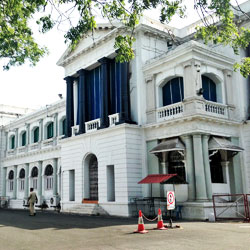
Fort St. George, on Rajaji Salai, is presently used as the offices of the Tamilnadu Secretariat and the Legislative Assembly. Today, it is the commercial heart of the city, throbbing with life from dawn to dusk, its streets packed with crowds of traders, buyers and their employees. Built by the East India Company the fort marks the beginning of Madras (Chennai) as a modern city.It was one of the first bastions of British Power in India. Fort St. George stands amid state offices facing the sea in the east of the city, just south of George Town. It looks more like a complex of well-maintained colonial mansions than a fort. Within its solid wall and sturdy gates is much that is historic.Clive's Corner, in the house where Rober Clive's lived commemorates the Empire-builder who first learnt his trade here. It houses the tallest towering Flagstaff in India. The black charnockite pillars of the building provide an insight into British military architecture of the 17th and 18th centuries. It once housed the British Regiment mess and later the lighthouse.
Explore More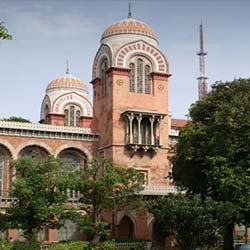
Just opposite to Anna Square is Madras University, whose ground and buildings are examples of the Indo-lslamic style of architecture. The 'Senate House' across the University is perhaps the best example of this style. This University is the mother of the Universities in Southern India, occupying a place of pride in the hearts of those who have passed through its portals in the nearly 150 years of its existence. It is a national centre for advanced research in plant pathology, mathematical physics, biophysics, and Indian philosophy. Instruction is in English and Tamil. Incorporated by an Act of the Legislative Council of India in 1857, the University of Madras was one of the first three Universities to be established in India. The University has over the years attained a reputation of its own as a premier University in the Indian sub-continent. Its alumni comprise some of the outstanding scientists including Nobel laureates, eminent statesmen, public figures, savants, exponents in all the fields of thought and arts and intellectuals in the humanities and social sciences. They occupy positions of importance in many world bodies, public and private organisations, state and federal governments, both in India and abroad.
Explore More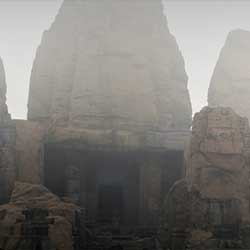
About 15 Kms. south of Kangra, this is the only shrine carved out of live rock in North India. Images of Ram, Sita, and Lakshman can be found in the sanctum of the main temple. Perhaps, Lord Shiva was originally worshipped here as indicated by the presence of the figures of Lord Shiva on the top of the entrance.
Explore More
Located in a quaint corner and away from the noises of the city, Krishnapura Chhatri is a popular and must-see tourist attraction. Erected in the traditional Maratha style of architecture, these chhatris are the cenotaphs of the royal Holkar family. The Holkar dynasty was the ruling dynasty in Indore that reigned for a prolonged period of time. To commemorate the rulers, these chhatris were constructed in their honor.Why Are Chhatris Popular?Each chhatri is a cenotaph that is dedicated to the Holkar kings that served the throne throughout their life. Their selfless dedication left a great impact on the hearts and minds of people that led to the construction of Krishnapura Chhatri.The second reason for them being a popular attraction is the jaw-dropping Maratha style of architecture and location near the River Khan. Such location of the tantalizing cenotaphs makes the site a must-see spot for all. It has a soul-soothing ambiance that refreshes the senses immediately.Best Time To Visit:-Krishnapura Chhatris in Indore are huge crowd pullers. Throughout the year, they attract visitors extensively and thus, it is a place that can be visited on a daily basis without hassle.The entry to Krishnapura Chhatri is free for all but littering the premises leads to a heavy penalty.Reaching There:-These enticing architectural marvels have a well-established network of roadways and railways that connect them with the rest of Indore. By hiring the service of the local transit, an individual can reach Krishnapura Chhatri conveniently.Nearest Railway Station:- Indore JunctionNearest Airport:- Rani Ahilya Bai Airport
Explore More4N Munnar - Thekkady Tour Package
5 Days/ 4 Night
Thekkady - Munnar
7N Alleppey - Kovalam - Kanyakumari - Rameswaram - Madurai Tour
8 Days/ 7 Night
Kovalam - Alleppey - Kanyakumari - Madurai - Rameshwaram
Delhi Heritage Tour 2 Days - 1 Night
2 Days/ 1 Night
New Delhi
Mathura Goverdhan Barsana Car Tour
1 Day
Mathura - Vrindavan

Jabalpur is a very popular city as it is located near the Narmada River in India and is also known as the Marble city. This is because the city houses the famous Marble Rocks that are popular across the country for its natural beauty. Ghats are places that are visited by thousands of people who are religious or have to perform last rites of their near and dear ones. Jabalpur city is one of the cities in India that has famous ghats such Tilwara ghat, Panchvati, Gawri ghat, Jelahrighat, etc. These ghats help in the tourism of the city as they visited by religiously inclined people across the country throughout the year. Most of these ghats are located outside the city where you can travel in taxis, buses or your own conveyance. Out of all these ghats, Tilwara Ghat, Jabalpur is one of the famous ghats that has both historical significance and is also religiously important. And that is why it is a place that tourists make sure to visit. Visitor information Tilwara ghat is a place that is popular for its beauty and natural landscape. It is also a place where many people go in the search of peace and calm and that is exactly what it provides. Since, it is not as developed as the other ghats in Jabalpur, Tilwara ghat retains its natural look. The ghat is around 12-19kms away from the city which is a driving distance from the main city. Thousands of visitors and tourists visit the ghat to see its natural beauty and the temples located in the ghat. Tilwara Ghat, Jabalpur as an Historical Attraction Apart from being away from the noise of the city and calm environment, the ghat is very welcome historically and has marked a place for itself in the history of India. This is the ghat where the ashes of Mahatma Gandhi were immersed. The visitors can also see the Gandhi Samark in the ghat. It is said that Mahatma Gandhi had visited the ghat during his stay in Jabalpur during his fight for independence. This ghat was also the place where Tripuri Congress’s opening session was held in 1936 in a dome shaped structure where one can still witness the National Flag hoisted over the dome. Things to do in Tilwara Ghat Apart from Gandhi Samark where many people pay their tribute to the Father of the Nation, the tourists or visitors can enjoy birdwatching. The ghat is filled with beautiful birds of different species. Visitors also visit this ghat to pray in the Tilwadeshwar temple which is a temple for Lord Shiva. The temple is an architectural attraction and is one of the oldest temples in Jabalpur. The other temples that you can visit in the ghat are Pisan Hari Jain temple, Mala Devi Mandira, etc. You can also go for boating with your family in the ghat. You will find many boats in the ghat that can take you on a ride on the river at most reasonable price. Best time to visit Tilwara Ghat, Jabalpur Tilwara Ghat, Jabalpur is open all throughout the year. However, the best time to visit the ghat is from November to May when the weather is pleasant. It is best to avoid Jabalpur during summers as it is very hot at the time. The total time taken to see the whole place is about 1-2 hours. The entry to the ghat is free of cost. Tips for Travelers Traveling to Jabalpur Tilwara Ghat, Jabalpur is a religious ghat and many people come to immerse the ashes or cleanse their body and souls to drown their sin in the holy water of Narmada. So, if you are traveling to the ghat or Jabalpur during summer, then ensure that you are visiting the ghat early in the morning. The weather is pleasant at the time and will also help you to protect yourself from the heat. Also, make sure that you are wearing a cap or carrying an umbrella to protect you from the harsh heat of the sun. Wear light clothes during summers and carry enough water to keep yourself hydrated. There are no restrictions in carrying the cameras, however, keep in mind that you are responsible for your own items. Since, it is a religious place and you have many temples in and around the ghat, you need to mindful of the cleanliness. Make sure that you are keeping the ghat clean by avoiding littering it. It is also very important that you take care of your children in the ghat or when near the river as the stones can get slippery. How can you reach the Ghat? The Tilwara Ghat, Jabalpur is between 12- 19kms away from the main city of Jabalpur. The city has local buses that go to the ghat from the city. You can also book a taxi or take your own car to visit the ghat. Restaurants to Eat in the Ghat Being a tourist place, the ghat has many good restaurants for family where you can eat your meals. Some of these restaurants include 19th Century, The Dome, Verandah, Back in Time, to name a few. Places to visit near the Ghat There are many shopping complexes or bazars where one can shop. Some of the famous bazars are Pushpa Plaza, Samdariya Mall, Gurandi bazar, Indira market, etc. The ghat is surrounded by beautiful Dhuandhar Falls, Marble Rocks, Chausat Yogini temple, Christ church, Free Manas Hall, etc. that are worth visiting. You can also buy the famous and beautiful marble rocks when you are visiting the ghat. Where to Stay in Jabalpur? Jabalpur has many hotels where you can stay. The city also has guest houses. If you are planning to visit the ghat, then you can also stay near the ghat that has many small but good hotels. The hotels offer all the comforts and basic necessities that one would need to stay for a short trip.
Explore More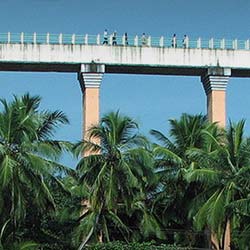
Mathur Aqueduct, or Mathoor Hanging Trough, is a hanging trough (bridge) and a popular tourist spot in Kanyakumari. It stands on Pahrali River and was built for transporting the water for irrigation purpose and to reduce the flood like situation. It is surrounded by a lush green hamlet and serves as a famous recreational site for everyone. It Is Known For:-1) Mathur Aqueduct was built in the year 1966 by the then CM of Tamil Nadu, K Kamaraj. It is the longest and highest aqueduct in South Asia as it has a total length of one kilometer and stands 115 feet tall2) The construction of this trough ended the problem of the shortage of water in the nearby taluks3) Due to its eye-catchy surroundings, it has emerged as a frequented tourist site in Kanyakumari. Tourists do not miss spending a few hours here4) Visitors can climb Mathur Trough and see a stunning view of the misty Western Ghats Best Time To Visit:-Many people adore visiting such places that are filled with serenity and provide calmness. Mathur Aqueduct is one among them and is visited on a large scale. It welcomes the visitors throughout the year. Reaching There:-Despite its location in a hamlet, Mathur Aqueduct has a huge network of roads that connect it with the rest parts of the city. By hiring the local buses and taxis, tourists can reach Mathoor village. From there, a short trek or a bullock cart ride can be relished till this trough. Nearest Railway Station- Kuzithura Railway StationNearest Airport- Trivandrum Airport
Explore More
David Hall appears as an old gorgeous Dutch bungalow which has a powerful historical background that is influenced by the Dutch traders of the 16th century. This bungalow was restored and brought back to life as an art gallery or cultural center especially for the contemporary art form and the motto of their project is to offer an effective platform for the blooming artists. So, the key factor about David Hall is it is not only an elite café but also a center of contemporary art, exclusive events and screening hall for award-winning films as well. All these factors together make this place a marvelous location to spend some effective time every day of your vacation. It is a vibrant and inspiring hall gallery café for foodies, art-lovers and fresh talents. If you go through the official website of David Hall Gallery Café you can identify why it is truly ‘where art meets life’. Don’t miss visiting the vintage exteriors with an open outdoor café and its large art hall. Well before finalizing your food or art destinations in Kochi you can certainly go through the online reviews posted by the previous visitors as well. Major allurements of David Hall, Kochi: David Hall cafe Do you have cravings for pizzas Check the special menus on their list – • 5 star rated clay-oven made thin crust fresh-baked pizza including chicken mushroom pizza, pepperoni bacon pizza, banana Nutella pizza, wood fire pizza, etc. • Seafood spaghetti • French toast of banana bread • Chips and fish • Various exciting seasonal juices including ginger lemon juice, watermelon juice, etc. • Iced tea • Banana smoothie • Cold coffee • Biryani • Grilled chicken • Burgers • Cheese tarts • Caesar salad • Crepes The specialty of David Hall food is it offers royalty with simplicity and exotic flavor. They offer limited items but truly in the best of their forms. You will be definitely impressed by watching the chef’s style of kneading the dough for baking pizzas. Even it can make you place another order of pizza on the row! It will definitely be a great experience to have a relaxing meal in a pleasant central location of Kochi. Get your taste buds ready to enjoy a good combo meal at the café of David Hall Kochi. Art exhibitions: Visiting David Hall can bring you some exciting opportunities to witness several exceptional art exhibitions here like the flaneur in Kochi, which is the paramount comic show of Kerala. A few other examples include Ken Johnsons wider circle, tribal art mela, ouso, and various contemporary art exhibitions held at different times. Film screenings: Various award-winning films of different countries including India have been screened in the hall. Land Gold Women is a very good example of that which is the winner of the purple orchid award, the national award of India and royal reel award. A few other films which had a screen here are Where the heart is, The last waltz and Festen. Events: Different paintings exhibitions and art exhibitions and sale often get organized here and have always pampered by the quality tourists of Kochi.
Explore More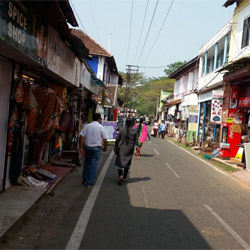
Kochi, a major city in the Ernakulam district of Kerala, is lined with many beautiful and mesmerizing tourist destinations. One among them is the Jew Town. Jew Town in Kochi is a very popular and vibrant part of the city that one should not miss out when here. It is not very expansive which might take you a lot of time. The place is just a small lane in between the popular Mattancherry Palace and Pardesi Synagogue. It is known for its old-world charm that entices tourists like ants to jaggery. As you reach the Jew Town area, you would be engulfed by the old world charm of the place. It is a reflection of the colonial era and has various antique and special items that will keep you glued. You can easily find here some really interesting pieces like carved wooden vessels, beautiful furniture, curios, and many other similar things. The items for sale here are from the Indian, Arab, Chinese, and European history. You can also find some exquisite handicraft items and garments that can make you fall in love with all of it. Things to Do One can explore the markets of Jew Town and buy some of the antique and handicraft items from the shops here. Not just that, the Vaarpu, a big bronze vessel that has handles on both its sides, is also a place that you should visit here. You can shop as much as you like. There are some beautiful things like wooden pillars, shiny and shimmery jewelry, metal and wooden figurines, crockery, wooden elephants, paintings, wall hangings, and much more here. Traveler Tips If you are planning to visit Jew Town, it is imperative that you wear some comfortable clothing and shoes as you may have to walk the streets. Also, having bargaining skills can help a lot here. You can certainly get these beautiful pieces from the Jew Town at a cheaper rate if you know how to bargain. Best Time to Visit People visiting Kochi, especially the Jew Town area, are always wondering which time is best for their travel to Jew Town. If the same question is on your mind too, we would suggest you make a visit to Jew Town during the months of February and March. Not just that, the best season would also be between the months of October and December as the weather is quite pleasant in Kochi. It is not too hot and humid and you can easily experience the true beauty of Jew Town. How to Reach Jew Town is located in Kochi, a city that is very easily accessible to all parts of Kerala. It is in Mattancherry which is connected to other parts of the city through the Jew Town Road. Road transport is very convenient to Jew Town. Apart from that, you can also take the railways to reach here. You need to get down at the Ernakulam Railway Station, located at a distance of just 10 km, from where you can take an auto or hail a taxi or cab to reach this town. People also take the ferry from the Marine Drive to reach the Mattancherry.
Explore More
Located in the heart of Kolkata in West Bengal, the Victoria Memorial is one of the major historical and heritage sites of India. Constructed with sparkling white marble this structure attracts hordes of tourists from all over the world. This memorial was built in the memory of Queen Victoria to celebrate her 25 years of rule over India. This famous structure is a replica of the Victoria Memorial in London. The Victoria Memorial is encircled by beautiful, lush green and well-maintained gardens containing plenty of statues and sculptures in it. There is a sixteen-foot tall bronze statue of victory that is mounted on ball bearings at the top of the Victoria Memorial. This statue serves to intensify the overall grandeur and appeal of the whole complex. This memorial of Queen Victoria is stunning and astonishing, especially at night, when it is lighted. The light and sound show that held in the evening is a must-watch and is an added delight. Overall, this amazing place is a must-visit for those who wish to remind the essence of the Victorian Era. History Of Victoria Memorial: Queen Victoria had become the figurehead of the country after the Revolt of 1857 and successfully controlled India until her death in 1901. The Memorial is one of the landmarks in the history of Indian architecture. All the credit goes to Lord Curzon who was the Viceroy of India then. In the year 1901, he placed the proposal of setting up a stately memorial for Queen Victoria, on her death. Lord Curzon gave the charge to Sir William Emerson (President of the British Institute of Architects) to design the structure and assigned the construction work to the famous company Messrs. Martin & Co. of Calcutta. The foundation stone had laid by the Prince of Wales, King George V on January 4, 1906. The memorial was formally opened to the public in 1921. Architecture Of Victoria Memorial: The chief architect of the Victoria Memorial, William Emerson has thoughtfully given an Indo-Saracenic style of architecture to the structure, while etching or drawing inspiration from Venetian, Egyptian, Mughal and other Islamic styles at the same time. The memorial is a 184 feet high building that is built with white color Makrana Marble that was brought from Jodhpur, Rajasthan. The huge gardens that surround the memorial, and sprawled over 64 acres, were designed and planned by botanist Lord Redesdale and Sir David Prain. Presently, the gardens are maintained by many gardeners and are a favorite destination for morning walkers. The gardens of the Memorial are home to numerous sculptures. There is a bronze statue of Queen Victoria on a bronze throne that welcomes the visitor at the entrance of the memorial. While a walk around the garden visitors can come across other statues of Curzon, Edward VII, Hastings, and Dalhousie. Timing And Entry Ticket For Victoria Memorial: • Victoria Memorial Gallery- The visiting time of this gallery is from 10 am to 5 pm. It is opened from Tuesday to Sunday. The entrance fee for Indians is Rs. 20/-, while for foreigners, the entry fee is Rs. 200/-. Students with school uniforms up to class 7th and army personnel do not need to pay any entry fee. • Gardens In Victoria Memorial- The gardens in Victoria Memorial are opened every day from 5:30 am to 6:15 pm, while the entry fee per person is Rs10, the yearly fee for senior citizens above 60-year-old is Rs.1000 and Rs.2000 for others. Galleries And Exhibitions Held In Victoria Memorial: There are over 25 galleries in Victoria Memorial including the Royal Gallery, the Sculpture Gallery, National Leaders Gallery, the Portrait Gallery, the Calcutta Gallery, and the Central Hall. The Memorial has an excellent and worthy collection of works of rare and antique books. The collection includes the adorned works of Shakespeare, the Arabian Nights and other books on dance and music. The memorial is undoubtedly a treasure trove of remarkable and noteworthy collections of weapons, paintings, textiles, artifacts, stamps, etc. A variety of informative exhibitions takes place at Victoria Memorial, along with many other events such as the celebration of important days and illustrated talks. Light & Sound Show In Victoria Memorial: Victoria Memorial arranges a light and sound show called Son-et-Lumiere from the month of October to June. This show does not showcase on Mondays, national holidays, Holi and other holidays. This show remains closed from the month of July to September. The show held in both Bengali and English. Tickets Of This show: Rs. 10 (Bengali), Rs.20 (English) Timings Of This Show: • From October to February: 6:15 pm - 7:00 pm (Bengali), 7:15 pm - 8:00 pm (English). • From March to June: 6:45 PM - 7:30 PM (Bengali), 7:45 PM - 8:30 PM (English) Tips For Visiting Here: • Photography is not allowed inside the main building of Victoria Memorial. • People, who are not interested in visiting the galleries, can take the ticket to visit the gardens here. The details for it can be enquired at the ticket counter. • There are many carriages available at the entrance of the Memorial for the visitors to enjoy a ride near the place. How To Reach Here: The Memorial can be easily reachable by all means of transport. Visitors can visit the place by bus, taxi, or an auto-rickshaw. For the Metro passengers, Maidan Metro and Rabindra Sadan Metro stations are the nearest Metro stations. Ferries are a quick and cheap alternative here and regularly taken from Princep Ghat and Bindan Ghat to reach the memorial.
Explore More
44 Kms from Konark is Pipli, a centre for applique work, which depict the essence of Oriya culture. It is also known for colourful and original awnings, canopies, garden and beach umbrellas, shoulder and handbags etc. The cocktail effect of the colours is certainly a feast for the eyes. Pipli, Orissa's appliqu capital, announces itself with loud colourful splashes of bright colour in the shop fronts. All kinds of handiwork are on sale in shops that line both sides of the main highway. Tour buses generally halt here for shopping.
Explore More
Cursetjee Fardoonjee Parekh donated this landmark structure Flora Fountain. Built in 1864, it was made of imported Poland stone and is located close to the church gate of the old (now vanished) British fort. Flora is the Roman Goddess of Flowers, her pretty alabaster face continually assaulted by grime and pollution. It stands at a busy five-point intersection in the heart of the commercial Fort area. The Flora Fountain was erected by the Agri-Horticultural society of Western India. It was originally meant to be named after Sir Bartle Frere, then governor of Bombay. However, the name was changed before the fountain was unveiled. It stood in the center of the town as it then was, but now this area is the heart of the business district of the town. This is the very heart of Mumbai, circumscribed by stately colonial buildings standing like proud old sentinels of a bygone era. Next to her are a pair of torch bearing stone patriots that rise from the Martyrs Memorial nearby. Flora Fountain is now called Hutatma Chowk or Martyr's Square to honour those who died in the tumultuous birth of Maharashtra State. All around the square sit Mumbai's infamous vendors selling just about everything under the blazing tropical sun - from cheap nylon saris to herbal remedies. Tooting horns and traffic complete the chaotic picture, but through it all Flora manages to retain her serene composure.
Explore More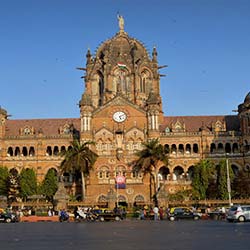
Opened on the New Year Day in 1882, this Gothic building housing the main railway station of Mumbai was designed by F.W.Stevens and was named after the then Queen Empress on Jubilee day in 1887. It is also declared as an urban heritage site. It was renamed as Chatrapathi Sivaji terminus in 1996 after addition of an underground suburban terminus. Presently, the headquarters of the Central Railway, this magnificent terminus building, commonly known as CST, was completed in 1888 for the Great Indian Peninsular Railway. It is one of the world's grandest railway stations, quite the equal of New York's Grand Central Station or London's St Pancras Station. It looks more like a cathedral than a railway station, an impression strengthened by the tall dome crowned with a statue representing 'Progress'.
Explore More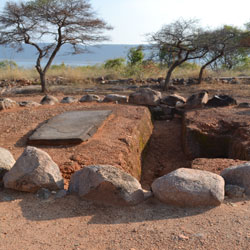
Nagarjunakonda is a historical Buddhist town in Andhra Pradesh. This place is known as one of the richest Buddhist sites in India. This place bears the name of Nagarjuna, a Buddhist saint that lived in the 2nd century. It is said that he was the one to spread Buddhism and activities related to it in the region. He also founded the Madhyamika School of Mahayana Buddhism. This place was ruled by the Ikshvaku dynasty for more than 150 years. Though this place is in a ruined state, it still lures visitors from all 4 directions of the country. It Is Known For:-1) The present-day ruined site of Nagarjunakonda was once a place where several educational institutions and Buddhist monasteries existed. Students from Bhutan, China, Gandhar, and Sri Lanka visited Nagarjunakonda to acquire knowledge about Buddhism2) After the civilization of this region was abandoned due to devastation, the ruins became the storytellers. The carved pillars were discovered during excavations3) Not only for the ruins of the Buddhist sites, Nagarjunakonda is also known for the nearby attractions like Ethipothala Falls, Nallamalla Hills, and Srisailam Wildlife Sanctuary Best Time To Visit:-The best time to visit Nagarjunakonda is between October-March. During these months, the temperatures do not shoot up and can cause discomfort while touring the place. Thus, it is recommended to choose a pleasant weather for visiting Nagarjunakonda. Reaching There:-Nagarjunakonda is an easily accessible site. Since it is located on the outskirts of the city, the local buses are frequently available for reaching the site. Nearest Railway Station- Nalgonda Railway StationNearest Airport- Vijayawada Airport
Explore More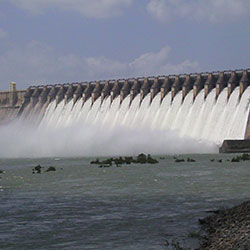
Nagarjunasagar Dam is a beautiful site of interest in the district of Nalgonda in Andhra Pradesh. This place is simply alluring because it is blessed with the enchanting and scenic surroundings where an individual can succumb to nature. It is visited by hundreds of people on a daily basis. The beauty of Nagarjunasagar calls the travelers from the different directions of the country. It Is Known For:-1) Nagarjunasagar is best-known for Nagarjunasagar Dam. It is an earthen dam that stands on the river Krishna and has a height of 490 feet from its foundation2) This dam is one of the earliest multi-purpose dams built in India. The main motive behind the construction of this dam was to generate the hydroelectricity and supply water for irrigation3) Due to its scenic surroundings, Nagarjunasagar Dam is a perfect place to spend a quality time away from the bustling cities. Many tourists arrive here and spend a jovial time. Best Time To Visit:-The best time to pay a visit to Nagarjunasagar Dam is throughout the year. However, one should avoid visiting the place during the daytime in summers due to the scorching temperatures. Tourists can enjoy boating in the reservoir created by this dam even during monsoons. Reaching There:-Nagarjunasagar Dam is a famous landmark in the district of Nalgonda. It has a well-established network of roadways as well as railways that make it easier for the travelers to reach the place. Frequent services of the local transit like the bus and cab are available that can be hired to reach Nagarjunasagar Dam. Nearest Railway Station- Nalgonda Railway StationNearest Airport- Vijayawada Airport
Explore More
Nagarjunakonda Caves is a historical site in Andhra Pradesh. This place is known as one of the richest Buddhist sites in India. This place bears the name of Nagarjuna, a Buddhist saint that lived in the 2nd century. It is said that he was the one to spread Buddhism and activities related to it in the region. He also founded the Madhyamika School of Mahayana Buddhism. This place was ruled by the Ikshvaku dynasty for more than 150 years. Though this place is in a ruined state, it still attracts visitors on a huge scale. It Is Known For:- 1) The present-day ruined site of Nagarjunakonda was once a place where several educational institutions and Buddhist monasteries existed. Students from Bhutan, China, Gandhar, and Sri Lanka visited Nagarjunakonda to acquire knowledge about Buddhism 2) After the civilization of this region was abandoned due to devastation, the ruins became the storytellers. The carved pillars were discovered during excavations 3) Not only for the ruins of the Buddhist sites, Nagarjunakonda is also known for the nearby attractions like Ethipothala Falls, Nallamalla Hills, and Srisailam Wildlife Sanctuary Best Time To Visit:- The best time to visit Nagarjunakonda is between October-March. During these months, the temperatures do not shoot up and can cause discomfort while touring the place. Thus, it is recommended to choose a pleasant weather for visiting Nagarjunakonda. Watch Out! If you’re visiting these caves post-sunset, do not forget to carry flashlights and extra batteries. The nearby hilly region is the place where you can enjoy the activity of camping. But, make sure that you are carrying all the essentials including the first-aid kit. Nearest Railway Station - Nalgonda Railway StationNearest Airport - Vijayawada Airport
Explore More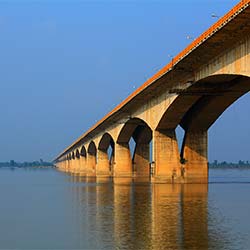
Mahatma Gandhi Setu is a renowned bridge in Patna. This bridge stands over the River Ganga and bears the name of Mahatma Gandhi. It is a 5.7 km long bridge and connects Patna and Hajipur. It has four lanes of the roadways and pedestrian paths. Many vehicles travel through this bridge on a daily basis. It Is Known For:- 1) It took a span of 10 years for the construction of this bridge. It happened due to the natural calamities and workers’ strikes 2) The huge amount of 88 crores INR was spent for the construction of the bridge. Gammon India Limited undertook the project 3) The toll gates existed but were removed officially on the orders of the government 4) The pillars supporting Mahatma Gandhi Setu are high enough to accommodate a ship under them 5) Slabs with hinges were used in the then times making it an engineering marvel of bygone times Best Time To Visit:- Mahatma Gandhi Bridge is a famous site and is visited on a huge scale. Many vehicles pass through this bridge on a daily basis. Watch Out! Presently, a major restoration work is going on at Mahatma Gandhi Setu. Thus, only the pedestrians can access the bridge. Reaching There:- Patna is well-connected to roadways, railways, and airways. Such connectivity makes it convenient to the reach the city. Many roadways buses, express trains, and flights are available from other cities of Bihar. You can travel within Bihar by the local transit. Nearest Railway Station - Patna Junction Nearest Airport - Patna Airport
Explore More4D Darjeeling - Mirik Tour Package
4 Days/ 3 Night
Darjeeling - Mirik
5N/6D Spiritual Triangle with Naimisharanya
6 Days/ 5 Night
Lucknow - Ayodhya - Prayagraj - Varanasi - Sitapur
Gangtok - Lachen - Lachung Tour
7 Days/ 6 Night
Gangtok - Yumthang - Lachung - Lachen
5N Srinagar - Pahalgam - Gulmarg - Sonamarg Tour
6 Days/ 5 Night
Srinagar - Pahalgam - Sonamarg - Gulmarg
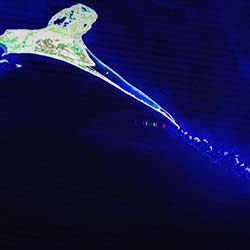
Separating the Gulf of Mannar from Palk Strait, Adam's Bridge is a long chain of the limestone shoals that connect Rameswaram Island to Mannar Island. This bridge is also known by the name of Rama Setu, the famous mythological bridge that was constructed by Lord Rama's army of Vanaras to reach Lanka. The entire bridge was built of the floating stones. It is a famous bridge and is visited by the tourists on a large scale. It Is Known For:-1) Adam's Bridge, popularly known as Rama Setu or Setusamudram, is a bridge that was built by utilizing the floating stones in the Hindu epic, Ramayana2) It is the oldest existing bridge in the world that wasn't constructed by man3) The southern tip of Dhanushkodi Beach, from where Rama Setu begins, offers a murky and dull view of Sri Lanka's Mannar Island Best Time To Visit:-Adam's Bridge, or Rama Setu, catches the attention of the people on a large scale. The domestic, as well as international tourists, visit this site from distant places to see the marvelous construction of the ancient India. It can be visited throughout the year. Reaching There:-To reach Adam's Bridge, one can hire the local taxi for few hours. A short drive till the Rameswaram Island can be enjoyed and close to Dhanushkodi Beach lies this enormous bridge that attracts millions of visitors annually. Nearest Railway Station- Rameswaram Railway StationNearest Airport- Madurai Airport
Explore More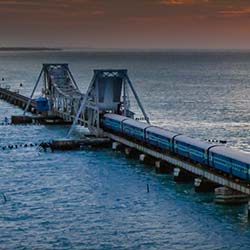
Pamban Bridge is a railway bridge in Rameswaram. This bridge connects the Pamban Islands to the main town of Rameswaram. It is a major site of attraction because it is India's first bridge that was constructed over a water body. Its total length is 6,776 feet and stands 41 feet above the sea level. It is entirely operational and trains pass through this bridge. It Is Known For:-1) Pamban Bridge is known as India's first railway bridge that stands on a massive water body. Its construction began in the year 1911 and was completed in the year 19142) This 2 km long bridge is equipped with a double-leaf bascule lift that can be raised for allowing the ships to pass3) In the year 2014, Pamban Bridge completed 100 years! 4) Not only this bridge but there's a road constructed parallel to it. It is another engineering marvel that is known by the name of Annai Indira Gandhi Road Bridge Best Time To Visit:-Pamban Bridge is a renowned attraction in Rameswaram and is visited by the tourists on a huge scale. The entire structure and engineering of this bridge catch the sight of the onlookers immediately. It welcomes numerous tourists throughout the year, excluding monsoons. During monsoons, there's a higher chance of tides and the authorities do not allow for enjoying the boat rides. Reaching There:-Being a prominent attraction, Pamban Bridge has a wider connectivity of the roadways. The local buses and jeeps are frequently available for reaching this enchanting place conveniently. Nearest Railway Station- Ramanathapuram Railway StationNearest Airport- Madurai Airport
Explore More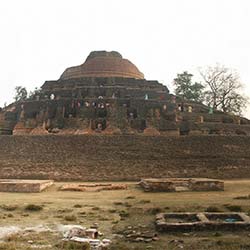
Raja Vishal Ka Garh is a well-known name in the list of tourist destinations in Vaishali, Bihar. Also known as Vaishali Garh, this place is believed to be the ‘Mother of Parliament’ in Bihar. Presently, it is a historical monument that is protected by the Archaeological Survey of India (ASI). Raja Vishal Ka Garh is believed to be one of the finest examples of the planned settlements in India. Why Is It Famous?1) Raja Vishal Ka Garh is a place from where many items related to the earliest human settlement were discovered during excavations.2) Gold coins, precious jewels, terracotta figurines, utensils, and deer horns were some major items were discovered.3) Apart from these things, Raja Vishal Ka Garh also had a fine drainage system for a free flow of water. Best Time To Visit:-October-March is the appropriate time for visiting the site. The pleasant weather makes it suitable for exploring the ruins of Raja Vishal Ka Garh. People are allowed to carry eatables. Nearest Railway Station - Hajipur Railway StationNearest Airport - Patna Airport
Explore More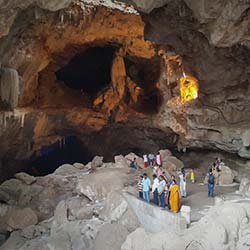
Borra Caves are a great point of interest in Visakhapatnam. These marvelous caves are found in the hills of Ananthagiri in Araku Valley. Borra Caves are listed among the largest caves in India and they are made up of Karstic Limestone. They have a depth of 260 that makes them the deepest caves in the country. According to the history, these caves were discovered in the early 18th century by William George from Geological Survey of India. It Is Known For:-1) Borra Caves are one of the largest caves in India2) Having a depth of 260 feet, they are tagged 'deepest caves in the country'3) An ancient rock Shivalinga that is claimed to be self-manifested was found by the shepherds when a cow slipped but remained unhurt4) Countless species of microorganisms are found in these caves5) Interestingly, the temperature inside Borra Caves remain 16°C-20°C throughout the year due to insufficient sunlight Best Time To Visit:-To visit and gaze at the natural rock formations inside Borra Caves, the appropriate time is during the months between January-March and August-November. During that time, the weather is perfect for exploring the caves and the nearby forests. The travelers need to carry extra food items as the food outlets are located far away. A flashlight is a must as there is no source of light inside the caves. Reaching There:-Since Borra Caves is located in a hilly region, reaching the place becomes a package full of fun. Travelers can reach the hills of Ananthagiri by hiring a jeep. After reaching the hilly area, a short trek can be relished to reach and explore Borra Caves. Nearest Railway Station- Vizag Railway StationNearest Airport- Visakhapatnam International Airport
Explore More
Nattakom and Panachikkad are the well-known holiday attractions located in Kerala. Located in the quaint corner of Kottayam (Kerala), Nattakom and Panachikkad are the whimsical villages that are extensively flocked by holidaymakers. Tourists, especially honeymooners consider these villages as the prime destination for spending their romantic holiday. If you are planning for your honeymoon without splurging, consider Nattakom and Panachikkad as the apt honeymoon destination. They Are Known For:- The dense forests they house. These forests are the perfect place to take delight in the venture of the wildlife safari. The Ayurvedic Massage and spa that is regarded as an ideal way to rejuvenate the limbs and senses. Bird Watching that can be enjoyed best during the months between November-February. Best Time To Visit:- Brace yourselves as you do not have to wait for any specific season to enjoy a holiday at Nattakom and Panachikkad. Throughout the calendar year, the vacationers throng to these villages for spending some time away from the hectic schedule of the life. If you love bird-watching, the best time plan a trip is November-February because the migratory birds make Nattakom and Panachikkad as their temporary residence. Reaching There:- These astounding villages have a well-established connection of roadways, railways, and airways. You can reach by availing the service of the public transports by paying a minimal charge. Nearest Railway Station- Kottayam Railway StationNearest Airport- Trivandrum International Airport
Explore More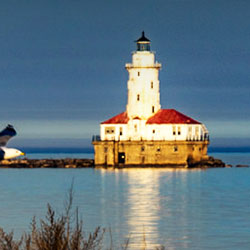
When you are in Kerala, you shouldn't miss Monroe Lighthouse. Also known by the name Munroe Lighthouse, it is a key attraction in the archipelago of Kollam. It is surrounded by the beguiling nature in the form of tantalizing islands and lakes. In the foregone times, when the British established their supremacy in South India, 2 officials were appointed by East India Company as administrative heads namely Colonel Colin Macaulay and John Munroe.During the tenure of John Munroe, this particular island was developed. He also built a lighthouse and a church on this island. Due to his great contributions, this island was renamed as Munroe Island and the lighthouse became a key attraction. It Is Known For:-1) The astounding natural surroundings that define it as a perfect tourist attraction2) Kallada Boat Race3) The coir weaving/retting process4) Watching the migratory birds5) The Dutch Church
Explore More